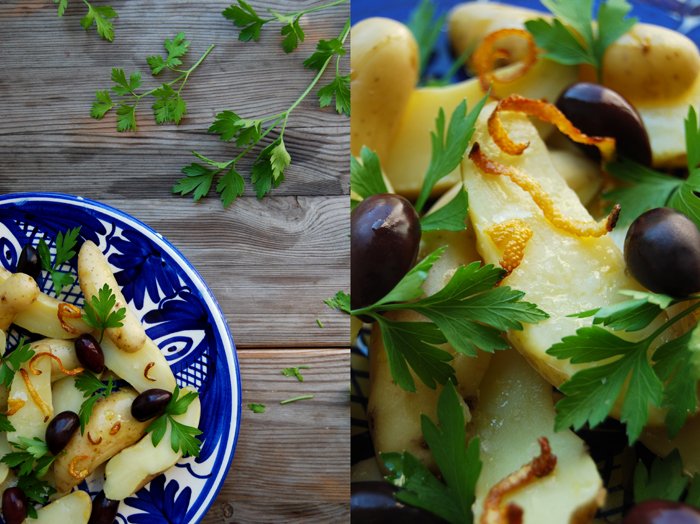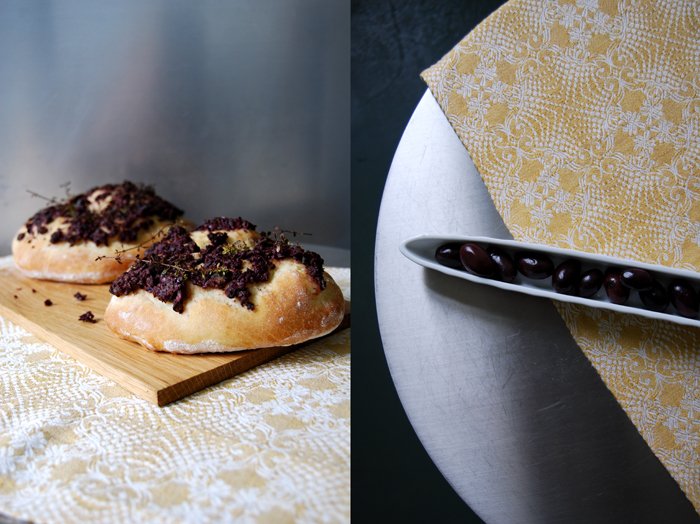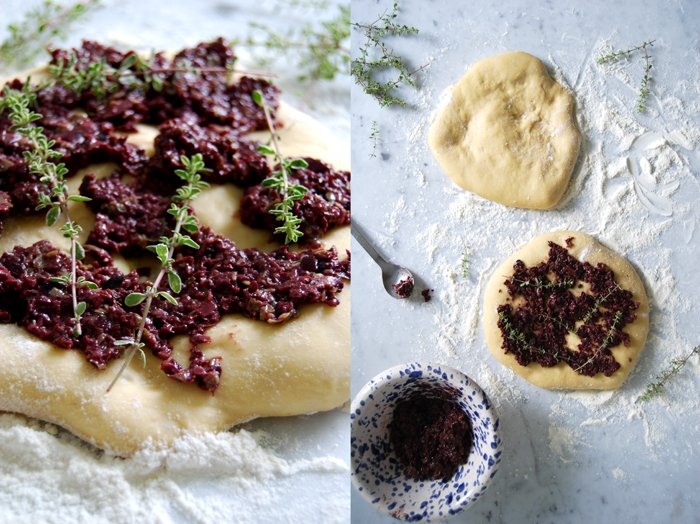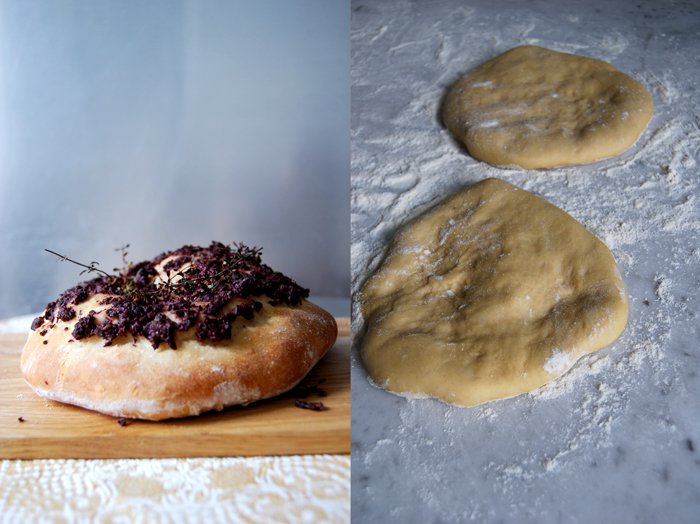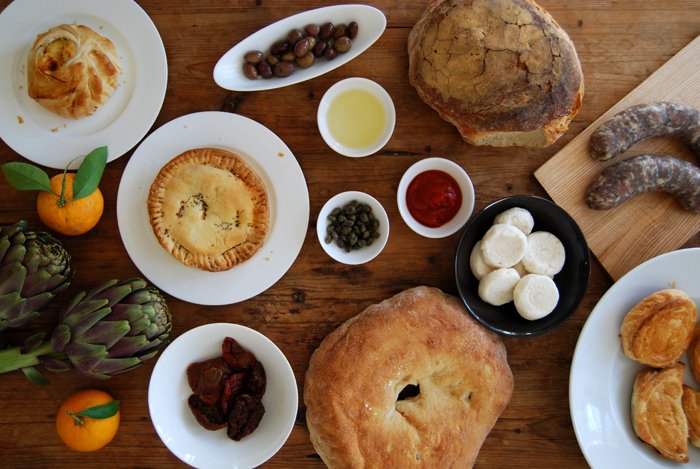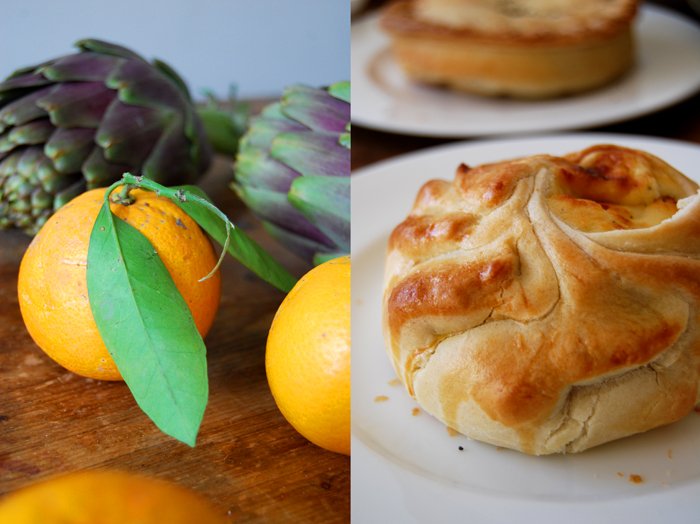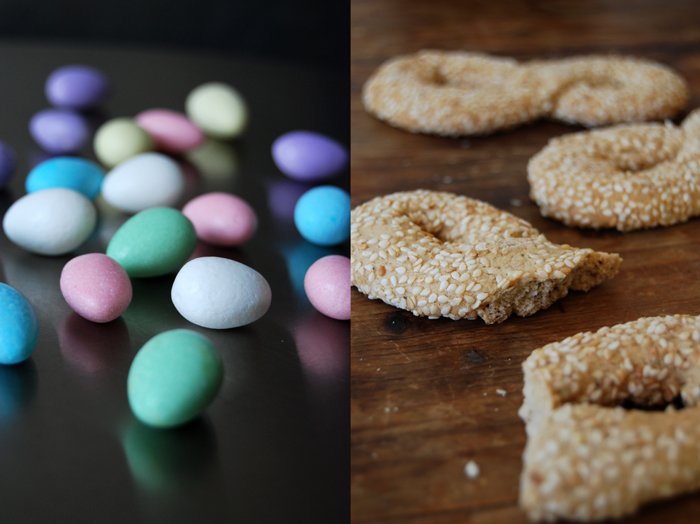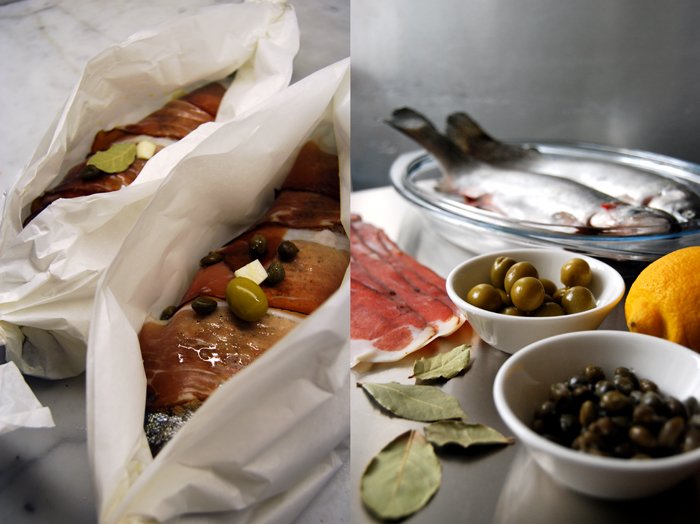Brook Trout al Cartoccio with Artichokes and Olives
A special guest calls for a special meal! My partner's mother Jenny came to visit us from Malta for a few days and, as always when we have a special guest, I got overly excited about planning our dinners and sightseeing trips days before she arrived. I love to have her here and it's been a while since her last visit so there was a lot to pack into six days!
During one of our last phone calls she asked if we could make a Bavarian Beer Roasted Pork. It's been years since I cooked it for her but she enjoyed it so much that she never forgot about our Bavarian night. Our first day together in Berlin was quite busy, I had to travel, my partner had a concert and we could only fit in a lunch. Inspired by all those wonderful Mediterranean seafood feasts we had at Jenny's house in Msida this summer, I wanted to present a fish of the north, brook trout. I love its earthy taste, somewhere between trout and salmon, and its beautiful pink colour. It's a member of the salmon family and lives in streams and brooks, although it's called trout it's actually a char. I prefer to cook sweet water fish al cartoccio wrapped in parchment pepper with spices, herbs and strong flavours like bacon or capers, like in my trout recipe. This method keeps the meat juicy and infuses it with all the delicate aromas it's filled with and wrapped in. For my brook trout, I chose artichokes, parsley, olives and bay leaves which bring out the best in any kind of sweet water fish. Cooked for about half an hour in some white wine, it just needed a fresh, crunchy baguette to dip into the juices to make a delicious lunch for my beloved guest!
Brook Trout al Cartoccio with Artichokes and Olives
For 2 people you need
brook trout 1 (about 500g / 1 pound)
black olives 10
small preserved artichoke hearts (tinned), cut in half, 6
parsley, a small bunch garlic, quartered, 3 cloves
bay leaves 2
white wine 100ml / 3.5 ounces
olive oil
salt and pepper
Set the oven to 180°C / 355°F.
Cut 2 pieces of parchment paper, about 20cm / 8" longer than the fish. Put them on top of each other and brush the top with olive oil. Lay the trout in the middle and season it with salt and pepper inside and out. Put 1 bay leaf and half of the parsley under the fish and the other bay leaf and the remaining parsley inside. Fold up the sides of the parchment paper, twisting the ends without closing it. Arrange the artichokes, garlic and olives around the fish and pour the wine over it. Close the top by folding it twice, put the cartoccio in a baking dish and cook in the oven for about 25 minutes.
The fish is done if you can lift the meat with a knife off the bone. Gently cut along the middle line on one side to check. If it needs a little longer fold the parchment paper to close it again and put it back into the oven for a few minutes. Enjoy with fresh baguette and a glass of white wine!
La Ratte Potatoes with Roast Lemon Peel, Olives and Parsley
A few weeks ago my boyfriend came up with a great chicken and red cabbage sandwich idea with an orange infused olive oil. He brushed the inside of the bread with this flavoured oil that we created by heating up a dish of olive oil and orange peel in the oven. The aromatic oil was wonderfully flavoured but the crisp citrus peel impressed me just as much! Since then I've used roast lemon and orange peel for my pasta, salads, couscous and risottos. The thin strips just need a few minutes to become golden crisps packed with flavour so it's important to take them out at the right moment. If you leave them in the oven for too long, they become bitter, and this can happen within seconds!
I have many ideas in my mind that feature both the wonderful oil and the crunchy strips, today's recipe combines roast lemon peel with potatoes, parsley and black olives to make a warm salad, great for lunch or as a side dish. I use the lemon flavoured olive oil as a dressing and the peel as a crunchy topping. It just needed some flaky sea salt for seasoning and it was done! I often use the French La Ratte potatoes for for these kind of potato salads, their taste is nutty and buttery and the skin is very thin. I don't even peel them, I just clean them with a vegetable brush and cut them in half when they are cooked.
La Ratte Potatoes with Roast Lemon Peel, Olives and Parsley
For 2-4 people you need
olive oil 3 tablespoons
lemon peel, cut into pieces, 6 long strips
La Ratte potatoes, cooked, (unpeeled) and cut in half, 14
fresh parsley leaves, a handful
black olives 12
sea salt
Set the oven to 200°C / 390°F (fan-asssited oven).
Put the olive oil and lemon peel in a baking dish and cook for 6 minutes or until the peel is golden and crisp.
Spread the potatoes on plates and mix them with the lemon infused olive oil. Sprinkle them with parsley, olives, roast lemon peel and salt and serve either warm or cold.
Spaghetti with Zucchini, Tomatoes, Olives and Basil
The beginning of July is the perfect time to throw a few of my favourite vegetables on a big plate of spaghetti. This dish is basically a Mediterranean Caponata, just without aubergine as it would have stretched the cooking time and changed the texture - I didn't want a juicy sauce, I was after some crunchiness! I mixed lots of zucchini with my Gozitan capers, anchovies and garlic and sautéed everything for a very short time. This way, the vegetables stay firm and fresh like a salad.
My tomatoes, olives and basil weren't even cooked, I just mixed them together with some olive oil into the warm pasta. When vegetables reach the peak of their season they don't need long to spread their aroma. Spoiled by the sun, strong in flavour and full of vitamins, they have this intense taste of summer that I've been waiting for for months. A few minutes in the hot pan and they were done, that's one of summer's kitchen qualities!
Spaghetti with Zucchini, Tomatoes, Olives and Basil
For 3-4 people you need
spaghetti 300-400g / 10.5-14 ounces
zucchini, cut in half and sliced, 350g / 12.5 ounces
anchovies, rinsed, dried and finely chopped, 1 1/2
garlic, thinly sliced, 3 cloves
capers 2 heaped tablespoons
tomatoes, cut into cubes, 350g / 12.5 ounces
black olives (whole or chopped) 8
fresh basil leaves 10
optionally: fresh mint, chopped, 5 leaves
black pepper
olive oil
Cook the pasta in lots of salted water al dente.
In a large heavy pan, heat a splash of olive oil, add the anchovies, garlic and capers and cook for 1 minute on a medium heat. Add the zucchini and a little more oil and cook for 5 minutes on high-medium temperature, stirring every now and then. Season with pepper (no salt!) and mix into the spaghetti, add a tiny bit of olive oil if the pasta is too dry. Stir in the tomatoes, olives, basil and mint and serve immediately. There should be enough saltiness from the anchovies and capers, I didn't need to add anymore.
Sicilian Sfincione with Tapenade
Forget thin and crisp, this pizza is thick and juicy! The Sicilian Sfincione is more like a focaccia, the dough is made with eggs and milk which gives it a bit of a sweet bread feeling. Its origin dates back to the late Baroque when the aristocratic Sicilian families liked to employ French chefs, the "Monzu" coming from the French Monsieur, some of them became famous Sicilian chefs. Here's the beauty of culinary exchange between two cultures, they influence each other, they don't confine each other but merge and evolve! If only cultural exchange was always so easy and well received!
In the beginning of the 18th century, these chefs started to influence Sicilian cuisine and left quite a few marks in the kitchen, also in the making of pizza. Eggs and milk, sometimes even butter, found their way into this famous dish and created completely different textures and tastes, like the popular Sfincione.
As there is already a French touch involved I thought I might as well continue working with it in the topping. I went for a rich Provençal tapenade made of lots of black olives, capers, anchovies, olive oil, brandy and lemon juice topped with thyme sprigs. It was great! This pizza is perfect for a picnic, as a starter or with a salad on the side. I love pizza, so much that I bake it every Sunday and this Sicilian variation is definitely a summer favourite!
Sfincione with Tapenade
For 4 Sfincione (15cm / 6") you need
For the dough
plain flour 500g / 1 pound
dry yeast 1 package (for 500g / 1 pound of flour)
salt 1/2 teaspoon
organic egg 1milk, lukewarm, 250ml / 8.5 ounces
Combine the flour with the yeast and salt, add the lukewarm milk and egg and mix with your dough hooks for a few minutes. Continue kneading and punching with your hands until you have an elastic dough ball and put it back in the bowl. Cover with a tea towel and let it rise in a 35°C / 95°F warm ( top / bottom heat, no fan!) oven for 45 minutes.
Divide the dough into 4, stretch into thick 15cm / 6" disks on a floured surface and cover with a kitchen towel. Let them rise while you continue the preparation for the tapenade.
For the tapenade
black olives 200g / 7 ounces
capers 40
anchovy, rinsed and dried, 2 fillets
olive oil 2 tablespoons plus more for sprinkling
brandy (or cognac) 2 tablespoons
freshly squeezed lemon juice 2 tablespoons
mustard 1 teaspoon
pepper
thyme 16 small sprigs for topping
Mix the ingredients for the tapenade in a blender and season with pepper to taste.
The Sfincione
Set the oven to 250°C / 480°F, my oven has a special pizza setting but you can use top / bottom heat as well. Line a baking sheet with parchment paper.
Spread a quarter of the tapenade on each pizza, put 4 thyme sprigs on top of each and bake for 6 minutes or until golden brown. Sprinkle with olive oil immediately and serve warm or cold.
Sole Meunière with a Mediterranean Tomato Confit
I went out to buy meat and came home with fish. The displays in the shops and markets have a huge effect on my shopping, often even more than my shopping list! A very fresh looking sole from the Atlantic caught my attention and I changed my mind, we'll have fish on the table instead! Sole caught in spring, in May and June is supposed to be the best, its taste is finer than during the rest of the year. This one is my first in 2014 and I gave it a Mediterranean twist. Tomatoes, black olives, capers, basil, garlic and a little freshly squeezed orange juice, these are the ingredients for my Mediterranean sauce, a thick and fruity tomato confit.
To fry a whole fish can be a bit intimidating, especially when it's as big as my sole, 650g (1.5 pounds) can be fiddly to flip around. I have a non-stick fish frying pan, a very convenient gift from my mother, which makes it much easier as its shape allows the fish to cook evenly. As long as your frying pan is big enough any other shape will do as well, I prefer non-stick as it needs less fat.
My sole is cooked whole, à la meunière coated in a thin layer of seasoned flour. The flour gave the recipe its name, meunière means miller's wife in French. I sautée the fish on high temperature in lots of olive oil and butter for just 3 minutes on each side. To prevent the fish from sticking to the bottom I shake the pan several times. There's a point of excitement involved in this recipe, and that's turning the fish. You should always do it quick and with confidence, I did it with my fingers pulling the fish up from its fin. Some use 2 spatulas or even another pan which I think is not necessary, just be brave and it will work!
Sole Meunière with a Mediterranean Tomato Confit
For 2 people you need
sole (whole), cleaned, rinsed and dried, 650g / 23 ounces (or 2 small ones)
plain flour for dusting
medium sized tomatoes, diced, 4
garlic, thinly sliced, 1 big clove
black olives, chopped, 4
capers, rinsed, 10
balsamic vinegar 1 teaspoon plus more to taste
freshly squeezed orange juice 1 tablespoon plus more to taste
salt and pepper
olive oil for frying
butter 1-2 tablespoons
For the tomato confit, heat a splash of olive oil in a sauce pan on a medium heat and cook the tomatoes and garlic for 2 minutes. Add the olives, capers, Balsamico vinegar, orange juice, salt and pepper and cook for 5 minutes (uncovered) or until thick and soft. Season with vinegar, orange juice, salt and pepper to taste.
On a large plate, season the flour with a little salt and pepper, toss the fish in, dust on both sides and shake off any excess.
In a large frying pan, heat a splash of olive oil and the butter on a high temperature and cook the fish for 3 minutes, shaking the pan 3-4 times. I cooked the white side first, some prefer to start with the dark side. Turn the fish with 1-2 spatulas (or from the fin like I did) and cook for 3 minutes on the other side until golden. If your fish is much smaller fry it for 2 minutes on each side only. Serve immediately.
The taste of Summer in my Mediterranean Sandwich
Maltese sausage, tomatoes, capers, olives, basil, red onions, garlic and olive oil on Maltese Ftira bread - as soon as I started to make this sandwich the sun came out, literally! You can't really put more of the taste of summer into a sandwich than in this one. In Malta, this is a local hero, the famous Ftira, enjoyed by everyone on this island. It's a celebration of their specialities combining quite a few different tastes, all strong and honest, and creating one of the best sandwiches you can imagine.
I made it last weekend when I had all the ingredients at hand, freshly delivered from Malta by Emma. I fried the coarse Maltese sausage with its strong coriander flavour until golden brown, without its skin and cut in half. It looked a bit like a burger stuffed with herbs. You can also use Salsiccia as it's made with similar spices and herbs as well. I recommend a white bread with a nice crust but soft on the inside to soak the juices and olive oil like the Maltese bread I used. I cut a few cherry tomatoes, half a red onion, 4 green olives, 1 dried tomato and a few basil leaves into slices and piled everything carefully onto a slice of bread drizzled with olive oil. I finished it off with 1 crushed clove of garlic and a few capers and closed it with another slice of bread. When I took a bite, I was on my favourite island in the Mediterranean again!
Hobz biz-Zejt u Tadam and more delicious Goods from the Maltese Rock
Today I will share some special food with you! I got a wonderful gift from Emma, my boyfriend's sister who lives in Malta and came to visit us for a few days. She put a big smile on my face when she opened her bag and I saw all the nice food she brought for me (well, not just for me actually). Emma knows which food I love and miss so much from her home island in the Mediterranean, especially now that it's been a few months since I was last there. Her gift reminded me of the taste and smell of this island which I got to know so well over the past years, during so many holiday trips and summers we spent there. Our family and friends, the food, the sea, so many memories connect me to this rock in the Mediterranean (this is what many Maltese affectionately call their home island).
This is a very personal introduction to Maltese food through my eyes and taste buds.
Whenever I'm in Malta, first thing in the morning I go to a wonderful traditional bakery, St. Josephs Bakery in Msida, to buy the most amazing white bread with the perfect crust. Every Maltese is proud of this bread and it's famous for good reason. There are two different types of bread, the big loaf called Hobz Malti (Maltese Bread) and the round Ftira with a hole in the middle. Usually, I cut thick slices off the loaf, dip them in olive oil and spread the sweetest tomatoes and some crushed pepper on top which makes the Hobz biz-Zejt u Tadam (Maltese bread with oil and tomato). There is also a famous (and quick) beach version which is made with Kunserva, a concentrated tomato paste full of ripe Maltese tomatoes and some mint or basil in between two slices of this amazing bread. There's nothing better than sitting on the beach after a long swim, this sandwich in your hands and your fingers staining with juicy tomatoes and olive oil - I love it!
Fruits and vegetables are heavenly in this sun kissed place, strong and honest in taste, ripe, with the flavours of a soil rich in clay. There's not much water, but the sun and the ground make up for it. My taste buds are always disappointed when I'm back home and have to get used to the store bought quality again. Maltese sausage is another speciality I'm very fond of as it's full of spices, the meat is coarse, its taste so strong that you can season a meal with it. Dairy products are limited, this rock isn't really made for cows, but the Maltese make a strong cheese from goat milk which is called Gbejna, delicious tiny round cheeselets. There are two kinds, the hard one which is a bit salty, great for salad and pizza, and the soft one, milky and mild. On the photos you see the hard ones from Gozo, Malta's sister island.
One of my favourite places is Busy Bee Confectionery where I get my daily dose of delicious cakes and pies. I love their sweet Mediterranean specialities like Cannoli, Cassata Siciliana and Ottijet (figure of 8 shaped tea time cookies with sesame seads). Unfortunately the Cannoli didn't survive the flight very well so I can't show them to you. On the savory side there is Qassata tal-Irkotta (a round short crust pie filled with ricotta), Pastizzi tal-Irkotta or tal-pizelli (puff pastry filled with ricotta or peas) and a huge Torta tal-Laham (Beef Pie), filled with tasty beef stew.
The colourful sweets are Perlini, filled with almonds, a traditional Maltese carnival treat.
Go visit and enjoy!
Luscious Bread with Black and Green Olives
Baking bread is a very relaxing and satisfying ritual. You mix the dough and watch it rise slowly, then you shape it and bake it in the hot oven where it doubles in size again. It's such a simple yet wonderful food, one of my favourites! Nothing beats a slice of fresh warm bread spread with butter or sprinkled with olive oil. So many people from different cultures celebrate this ritual, with similar recipes even though they live on opposite sides of the world. It's one of our traditions that connects us and shows how much we have in common.
I have a good friend who lives in Sydney and whenever he comes to Berlin we all meet at our's together with a few of our friends. Sometimes it's a big dinner, sometimes we just have some wine and snacks. The only problem is that he never tells me in advance, it's a very spontaneous thing, he's just here at one point. Followed by another 10 - 15 people. This calls for some improvisation tricks in the kitchen, we just have to eat what my fridge offers!
Around two years ago he called to announce his arrival and I was lucky to have a few pumpkins in my kitchen, so a soup for 10 was quickly thrown together. For whatever reason I had lots of black olives as well. I like to have more than enough good bread on my table when it's a long night so I decided to bake 2 loaves of olive bread with lots of olives and olive oil, juicy enough to nibble on after finishing the soup. The texture is light but you taste and feel the olives and the olive oil, it makes the bread really smooth. Everybody loved it and couldn't stop eating it. This was a feast to me, it always is, sitting together with friends at my long wooden table, talking, laughing and enjoying some red wine and nice bread.
Tomorrow it's my Sandwich Wednesday again and I will make a special sandwich with this bread which is very popular in the Middle East!
A Juicy Bread with Black and Green Olives
For 1 loaf of bread you need
plain flour 250g / 9 ounces (I use spelt flour type 630 but you can use any other plain flour)
dry yeast 1 tablespoon
salt 1/2 teaspoon
a pinch of sugar
water, lukewarm, 70ml
milk, lukewarm, 70ml
butter 1 tablespoon
olive oil 2 tablespoons
black and green olives, chopped, 60g / 2 ounces
Combine the dry ingredients and add the water, milk, butter and olive oil. Mix with your dough hooks till everything is combined. Add the olives and continue mixing for a few minutes. Continue kneading and punching with your hands until you have an elastic dough ball, it will be a little sticky but that's fine. Put the dough back into the bowl and cover with a tea towel.
Option1:When I prepare the dough the day before I bake it, I put the bowl with the dough in the fridge (covered with cling film) and let it rise overnight. You will have to take it out of the fridge 30-60 minutes before you can continue with the next steps.
Option 2:In case I want to bake my bread the same day, I let the dough rise in a 35°C / 95°F warm oven for 45 minutes. This works really well but make sure that your oven is set to top / bottom heat and not to fan.
When the dough has doubled in size, take it out, punch it down and knead with your hands for 2 minutes. Form the dough in a long loaf shape and put it on an oiled baking sheet. Cover with a tea towel and let it rise for another 25 - 35 minutes in a warm place.
Set your oven to 200°C / 390°F top / bottom heat.
Bake the bread for 30 minutes or until cooked through. If you're not sure if it's done turn the bread around and knock on its underside, it should sound hollow. Let it cool for 5 - 10 minutes, cut a thick slice off it and drizzle some olive oil on top, just a bit, and sprinkle with salt.
Butter Bean and Fennel Soup
It's time for soup! The colder it gets the more I feel like food that is up-lefting and soul-warming. Something that makes me feel strong and prepares me for the cold, dark months ahead of me. Although I love winter, the snow, even the cold, when you get cosy inside, slow down and relax, it's important to treat yourself to the right food to renew your body and mind.
I'm in the mood for a thick soup, smooth but light - like my Minestrone with big butter beans and fennel with some parsley and black olives sprinkled on top. The texture is velvety and it tastes a bit sweet. Today I add a piece of bacon to it as I feel like something deeper in taste. Usually I cook the vegetarian version, I don't prefer one over the other, both are nice winter treats!
Butter Bean and Fennel Soup
Keep in mind that you have to soak the dried beans in water overnight. I like to cook soups in bigger batches to store some in the freezer - great for busy days. This recipe is for 4 people, sometimes I even double the amount.
dried butter beans or Cannellini beans, soaked in cold water overnight, 250g / 9 ounces
fennel, rinsed, cut in thin slices, 300g / 10.5 ounces
celery stalk, cut in cubes, 1
onion, cut in cubes, 1
broth or water, around 1500 ml
optional: a piece of bacon, 40g / 1.5 ounces
garlic, crushed, 1 clove
bay leaf, 1
salt and pepper
olive oil for frying
parsley, chopped, for the topping, 2 tablespoons
black olives, chopped, for the topping, 4
good olive oil, for the topping
Heat some oil in a large pot. Fry the onion, celery, garlic and bacon (left in one piece) for a few minutes. Add the fennel, take the beans out of the water and put them into the pot as well. Fill with broth, add the bay leaf and close with a lid. Don't season with salt before the beans are done or they won't become soft. Cook for 30 minutes or until the beans are soft. Depending on the bean's texture it may take another 30 minutes. Mine needed 60 minutes today but I must admit that I found them in a dark corner of my shelf.
When the beans are done, take out half of the vegetables (cooked beans and fennel) and put them to the side. Mix the other half of the vegetables together with the liquid in a blender and season with salt and pepper. Put everything back into the pot together with the remaining vegetables. When you arrange the soup in soup bowls sprinkle with olives and parsley and drizzle your best olive oil on top.
Trout al Cartoccio
Today I found some beautiful, fresh trout and they reminded me of the region where I grew up. Of the forest and its little streams meandering between trees, passing by the trout ponds which are close to my mother's house. I decided to get two of them and cook them al cartoccio - in parchment paper - together with Tyrolean prosciutto, olives, capers, garlic and bay leaves.
Trout has a strong, earthy taste which makes it perfect to combine with other stand out flavours. The closed parchment paper package makes this union of tastes even more intense. As extreme as this combination may sound, it is a perfect match. The trout can take the smoky prosciutto, the bay leaf, the olives and capers without loosing any of its own qualities.
The best part is opening the hot paper package on your plate and smelling the different aromas. Dip some bread in the juices and enjoy with a glass of white wine!
Trout al Cartoccio with Tyrolean Prosciutto, Olives and Capers
For 2 people you need
whole trout, cleaned, 2 (each around 300g / 10.5 ounces)
Tyrolean prosciutto, thin slices, 6 (or any other Italian prosciutto)
green olives 8
capers 2 tablespoons
garlic, quartered, 2
bay leaves 4
white wine 100ml
olive oil 4 tablespoons plus more to brush the parchment paper
salt and pepper
a small loaf of Ciabatta, for serving
parchment paper, to wrap the trout
Set your oven to 180°C / 355°F.
Rinse and dry the fish, season with salt and pepper (inside and out).
You need to prepare 2 parchment paper packages for 2 trout: for each package put 2 layers of parchment paper on top of each other, each around 20cm / 8" longer than the fish. Brush the top layer with oil.
Wrap each trout in 3 slices of prosciutto and place it in the middle of your oiled parchment paper. Put one bay leaf in the fish and one below. Fold up the sides of your package, twisting the ends without closing the top and fill with half of the olives, capers, garlic, olive oil and white wine. Close the top and fold twice. Repeat with the second trout.
Place both bags in a baking dish or pan and put in the oven for 10-12 minutes (depending on the size of the fish). You can tell the fish is done when its earthy smell starts to fill the air. Carefully open one of your packages, if you can lift the flesh off the bone with a fork it's done.









